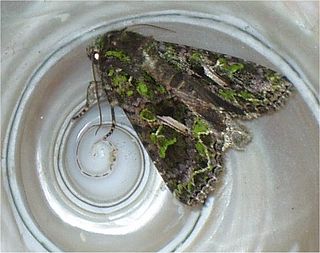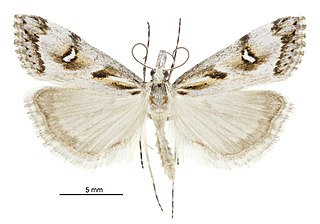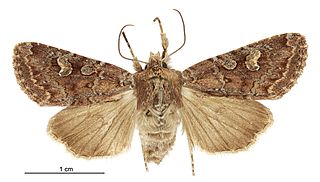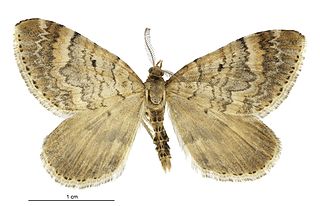Hyodectis is a genus of moth in the family Gelechiidae. It contains only one species, Hyodectis crenoides, which is found in Australia, where it has been recorded from New South Wales and Victoria.

Caradrina clavipalpis, the pale mottled willow, is a moth of the family Noctuidae. The species was first described by Giovanni Antonio Scopoli in his 1763 Entomologia Carniolica. It is found in the Palearctic realm. It is an introduced species in North America, where it was first reported from Queens in New York City in 1993. In 2009 it was found in Rochester, New York, so it appears to be established and spreading.

The Orache Moth(Trachea atriplicis) is a species of moth of the family Noctuidae. It is found in all of Europe, east across the Palearctic to the Pacific Ocean and Japan.

Coleophora serratella is a moth of the family Coleophoridae. It is found in Europe, Japan (Hokkaido) and North America.

Grotella septempunctata is a moth in the genus Grotella, of the family Noctuidae. The species was first described by Leon F. Harvey in 1875. It can be found in North America, from Texas to Colorado.
Etielloides curvella is a species of snout moth in the genus Etielloides. It was described by Shibuya in 1928, and is known from Japan.

Schiffermuelleria orthophanes is a moth of the family Oecophoridae. It is endemic to New Zealand. It is classified as critically endangered by the Department of Conservation.
Cathelotis is a monotypic moth genus in the Copromorphidae family. Its sole species is Cathelotis sanidopa, which is found in Colombia.
Rhopalosetia is a monotypic moth genus in the family Copromorphidae. Its only species, Rhopalosetia phlyctaenopa, is found in French Guiana. Both the genus and species were first described by Edward Meyrick in 1926.

Gadira leucophthalma, commonly known as the beaked moss moth, is a moth in the family Crambidae. It is endemic to New Zealand. It is found in the south eastern side of the South Island down to Banks Peninsula. G. leucophthalma inhabits the foredunes of coastal areas. The larval host is unknown but it has been hypothesised that the larvae feed on moss. The adult moths are day flying although some specimens have been trapped at night via light traps. Adults are commonly on the wing from March to April. This species has been classified as Nationally Vulnerable by the Department of Conservation.
Epipsestis mediofusca is a moth in the family Drepanidae described by Yoshimoto in 1982. It is found in Nepal and Tibet, China.
Mimopsestis is a monotypic moth genus belonging to the subfamily Thyatirinae of the Drepanidae. It was described by Shōnen Matsumura in 1921. Its single species, Mimopsestis basalis, was described by Wileman in 1911. It is found in Japan and the Chinese provinces of Henan, Shaanxi, Hubei and Hunan.
Diplogrypa is a genus of moths of the family Oecophoridae erected by Ian Francis Bell Common in 1997. It contains only one species, Diplogrypa microptera which was first described by Turner in 1916 and is found Australia, where it has been recorded from Queensland.
Agonopterix likiangella is a moth in the family Depressariidae. It was described by Alexandr L. Lvovsky and Shu-Xia Wang in 2011. It is found in Yunnan, China.

Thambotricha is a monotypic genus of moths in the family Epermeniidae. Its sole known species, Thambotricha vates, is also known by the vernacular name wonder-haired prophet. It is endemic to New Zealand. This species is classified as "At Risk, Naturally Uncommon" by the Department of Conservation.
Chariphylla is a monotypic moth genus in the family Depressariidae. Its only species, Chariphylla closterias, is found in Peru. Both the genus and species were first described by Edward Meyrick in 1921.
Callizyga dispar is a moth in the family Depressariidae, and the only species in the genus Callizyga. It was described by Turner in 1894 and is found in Australia, where it has been recorded from Queensland and New South Wales.

Ichneutica agorastis is a moth of the family Noctuidae. This species is endemic to New Zealand. This moth is similar in appearance to two other species in the genus but can be distinguished through the colour and size of its forewings. This species is found in the South Island and Stewart Island in open habitats in the subalpine zone. However in Southland I. agorastis can be found down to sea-level. Adult moths are on the wing between January and April. The life history and host species are unknown.

Asaphodes cosmodora is a species of moth in the family Geometridae. This species is endemic to New Zealand and has been observed in the South Island. The adults of this species are on the wing in January and February.

Asaphodes dionysias is a species of moth in the family Geometridae. This species is endemic to New Zealand and is only known from mountainous areas in Central Otago. It lives in open grassy mountainous habitat at altitudes up to 1750 m. It is also known to live in wetland habitat. The larvae of this species feed on native herbs. The adults of this species are on the wing in January and February. The adult female of the species has reduced wing size in comparison to the male.










